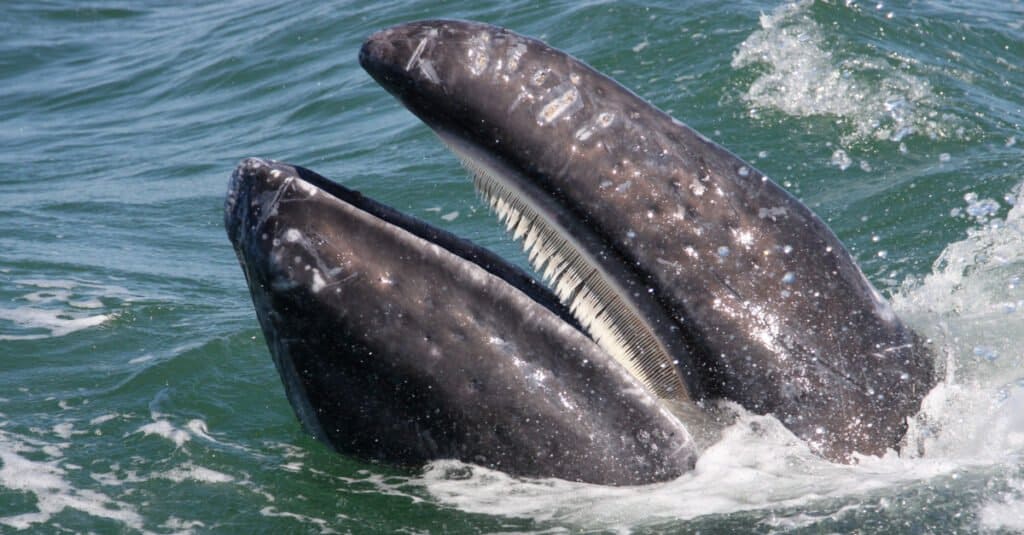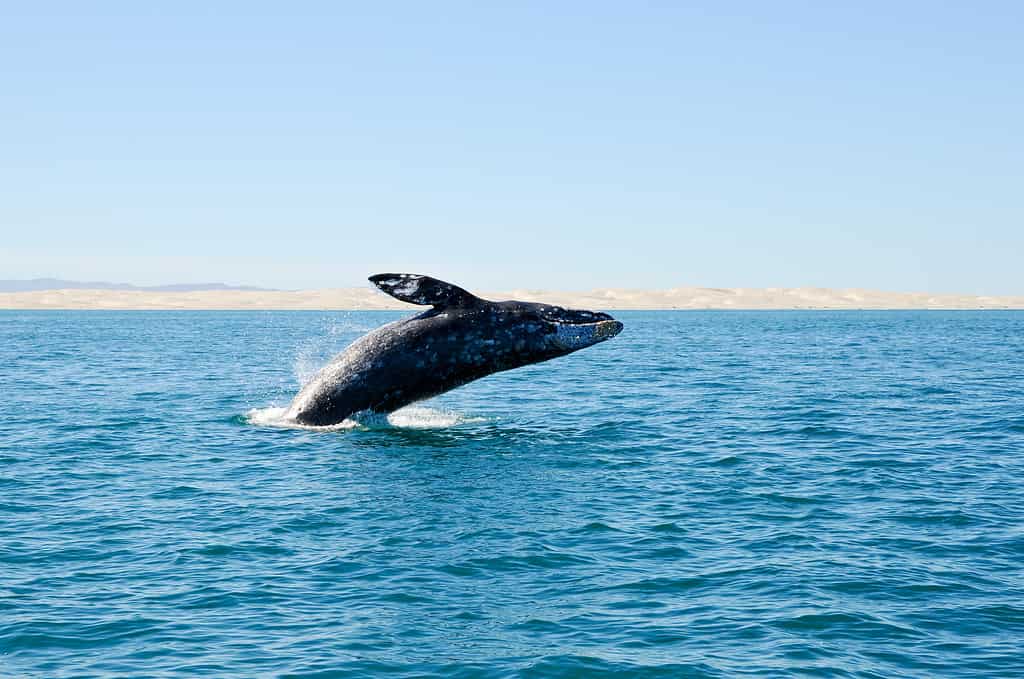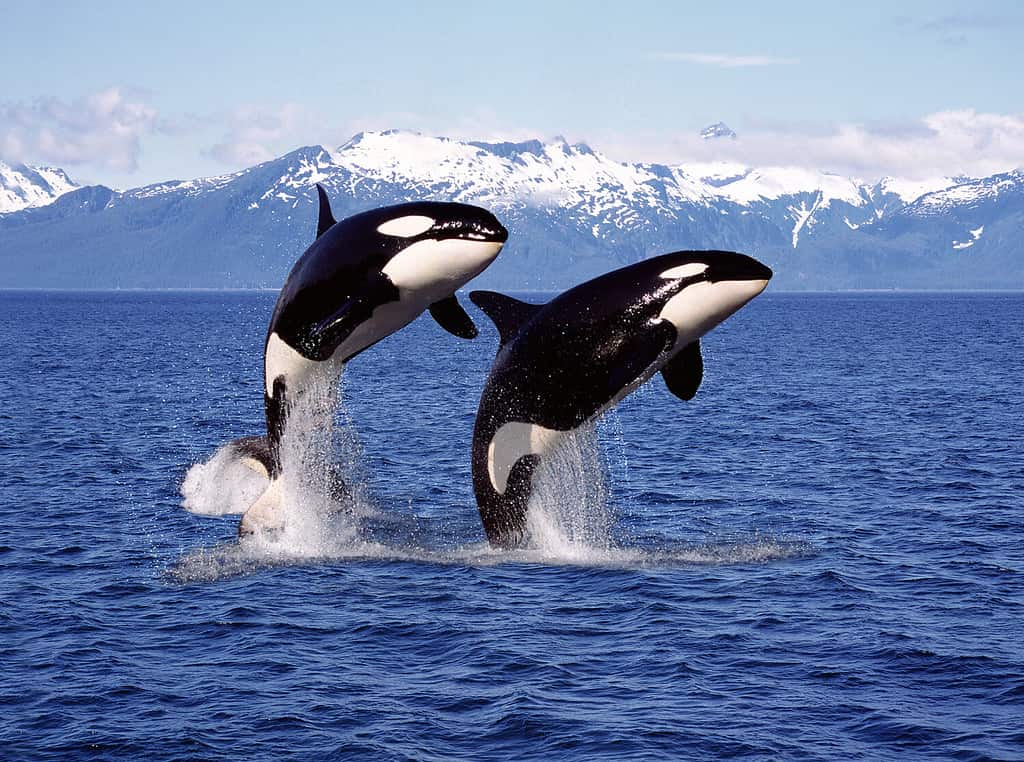Gray whales (Eschrichtius robustus) are majestic marine mammals that inhabit the North Pacific Ocean. They are easily recognizable by their distinctive appearance, marked by mottled gray skin covered in barnacles and scars. Gray whales possess baleen plates instead of teeth and employ a unique feeding strategy to consume small, bottom-dwelling organisms like amphipods. These gentle giants are renowned for their incredible annual migration, one of the longest of any mammal on Earth. Their journey takes them from Arctic feeding grounds to the warm waters of Baja California, Mexico, for breeding and calving. In this deep dive, we explore the remarkable world of gray whales to discover the unique role they play in our marine ecosystems.

Gray whales are magnificent marine mammals that inhabit the North Pacific Ocean.
©Mogens Trolle/Shutterstock.com
Taxonomy
| Classification: | Gray Whale |
|---|---|
| Domain: | Eukaryote |
| Kingdom: | Animalia |
| Phylum: | Chordata |
| Class: | Mammalia |
| Order: | Artiodactyl |
| Infraorder: | Cetacea |
| Family: | Eschrichtidae |
| Genus: | Eschrichtius |
| Species: | Eschrichtius robustus |
Physical Characteristics
The gray whale is a medium-sized baleen whale weighing an average of 72,000 pounds (5,143 stones). However, some grow to be much heavier. These massive creatures can reach lengths of 40 to 50 feet (12 to 15 meters). Their most notable feature is their mottled gray skin. It is often adorned with patches of white barnacles and scars from parasites, giving them a weathered and unique appearance. These majestic mammals possess a streamlined body with a small, narrow head and a pronounced arched jawline. Unlike toothed whales, they lack teeth and instead have baleen plates, which are fringed, hair-like structures used for filter-feeding. They live between 50 and 70 years.
History
Once common throughout the oceans of the Northern Hemisphere, gray whales were all but decimated by the commercial whaling enterprises of the 19th and 20th centuries. The only extant (living) species of gray whale that remains is the eastern North Pacific gray whale (Eschrichtius robustus). There are several known extinct species and subspecies in the fossil record.
Habitat
Habitat preferences for this species vary depending on the season and their life cycle stages. However, gray whales are not deep-water creatures. They prefer shallow, protected lagoons and bays for breeding and calving. Their primary feeding grounds are also shallow. The migration routes they take between these areas often follow coastal regions.
During the summer and early autumn months, gray whales migrate to their feeding grounds in the Arctic. These feeding grounds are in the Bering and Chukchi Seas and are relatively shallow. These whales are bottom feeders, using their specialized feeding behavior to extract small crustaceans (amphipods) from the ocean floor. Their feeding grounds are rarely deeper than 200 feet (60 m).
In the winter months, from late autumn to early spring, they migrate to their breeding and calving grounds. These are found in the warm, shallow lagoons and bays of Baja California, Mexico. Coastal lagoons provide a relatively safe environment for giving birth and nursing. They also provide protection for mothers and calves from predators like orcas.
During their twice-yearly migration of 5,000–7,000 miles between their feeding and breeding grounds, gray whales follow nearshore routes, often within a few miles of the coastline. While they may occasionally stray into open water along the way, their primary destinations are the shallow feeding ground in the Arctic and the protected lagoons of Baja California.

These whales lack teeth. Instead, they have baleen plates, hair-like structures used for filter-feeding.
©jo Crebbin/Shutterstock.com
Diet
Their primary food source is a group of small, shrimp-like crustaceans called amphipods. Gray whales are known to feed on various species of amphipods. This is especially true of those found in the muddy sediments of their feeding grounds in the Arctic. They are especially fond of a species known as Ampelisca eschrichtii. These little critters are 0.5 inches (15 mm) long and are found in abundance on the northeastern Sakhalin Island Shelf.
Gray whales are bottom feeders, and they employ a unique feeding behavior known as mud-wallowing.
Descending to the ocean floor, in relatively shallow waters, the gray uses its large head. Tilting its body downward, it scoops up a mouthful of sediment and amphipods from the ocean floor. As the whale closes its mouth, it expels the water and mud through its baleen plates. The amphipods are trapped by the baleen, while the water and mud are filtered out. The whale then uses its tongue to scrape the trapped amphipods from the baleen, swallowing them. These large animals can consume as much as 2,400 pounds (1089 kg) of amphipods daily!
These whales are seasonal feeders. They undertake long migrations from their breeding and calving grounds in the warm waters of Baja California, Mexico, to their feeding grounds in the Arctic. During the summer months, they feed extensively in these nutrient-rich Arctic waters, building up energy reserves for the long journey back. Gray whales are not strict specialists in their diet, and they may also consume other prey items, such as small fish or other invertebrates, when available. However, amphipods are their primary and preferred food source.

Gray whales undertake long migrations from the warm waters of Baja California to the Arctic.
©Jan-Dirk Hansen/Shutterstock.com
Communication
Gray whales are known for their vocalizations, which play a role in communication and social interactions. Here are some of the sounds they make:
- Clicks: Gray whales produce a series of rapid, high-pitched clicks that are often used for echolocation. These clicks help them navigate and locate prey, such as small crustaceans on the ocean floor, in the murky waters of their feeding grounds.
- Moans and Whistles: Gray whales also produce moaning and whistling sounds. These vocalizations are believed to be associated with social interactions and communication between individuals, particularly between mothers and calves.
- Singing: While not as famous for their songs as humpback whales, gray whales have been known to produce melodic, repetitive sequences of sounds. These songs are most often associated with males during courtship and mating behaviors.
- Bubble Clouds: Gray whales sometimes create underwater bubble clouds as they blow air through their blowholes while submerged. These bubble clouds can be visually striking and are often accompanied by various vocalizations.
Their vocalizations are typically lower in frequency and less complex than those of some other whale species. The exact purpose and function of these sounds is still not fully understood, as gray whales are generally less studied in this regard compared to more vocal species like humpback whales. Researchers continue to study and learn more about the communication and vocal behaviors of gray whales to gain insights into their social interactions and behaviors.
Predators, Threats, and Conservation Status
Gray whales have evolved various adaptations and behaviors to minimize predation risk. They have relatively few natural predators, especially among large marine mammals. Historically, the primary threat to gray whales has been human hunting. Commercial whaling severely depleted their populations in the past, but they have since been protected by international regulations, and their populations have slowly recovered. However, the main threats to gray whales continue to be human-related, such as entanglement in fishing gear and ship strikes, as well as environmental changes caused by human activity.
Orcas (Orcinus orca) are one of the few natural predators of gray whales. They are known to hunt calves, especially during their migration from the breeding grounds in Baja California, Mexico, to their feeding grounds in the Arctic. Orcas are highly intelligent and work together in coordinated attacks to separate and target vulnerable gray whale calves.

Orcas are one of the few natural predators of gray whales.
©slowmotiongli/Shutterstock.com
Environmental factors such as climate change and the lack of available food are posing threats to gray whales. Alterations in their habitat and food supply are negatively affecting the population. Evidence includes a dramatic rise in gray whale strandings in recent years. These whales have shown signs of malnutrition. That said, they are not considered endangered. As of 2023, they are listed as a species of least concern. Though their population is small, at approximately 14,500, it is considered stable.
More Interesting Facts
- Gray whales are often referred to as living fossils because their lineage dates back 30 million years. They are one of the oldest species of baleen whales still in existence.
- They are known for their curious and friendly behavior towards boats and humans. They sometimes approach vessels, where they may spy-hop (raise their heads out of the water to look around) or even allow humans to touch them.
- These whales often have distinctive scars and markings on their skin, caused by barnacles, parasites, and sometimes even the bites of cookiecutter sharks (Isistius brasiliensis). These markings are used to identify individual whales.
- Gray whale calves are 16 feet (5 m) long and weigh 2,000 pounds (907 kg) at birth.
- Whalers referred to grays as devil fish for their violent reactions to being harpooned.
The photo featured at the top of this post is © Mogens Trolle/Shutterstock.com
Thank you for reading! Have some feedback for us? Contact the AZ Animals editorial team.







